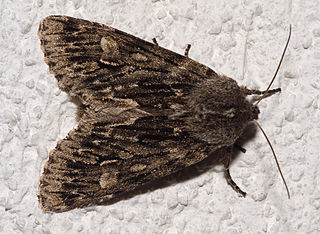
Brachionycha nubeculosa, the Rannoch sprawler, is a moth of the family Noctuoidea. It is found across the Palearctic from the British Isles in the west, across central and northern Europe over Russia, Siberia to China. The species is only locally distributed in central Europe, but is often relatively common in this region. In southern Europe, the occurrence is limited to some mountainous regions. In Germany, it reaches as far as the summit regions of the low mountain ranges. The species is moisture loving and prefers moist, cool temperate forests, mixed forests, wooded valleys, river and stream edges as well as orchards.

Katha depressa, the buff footman, is a moth of the family Erebidae found in Asia and Europe. It was first described by Eugenius Johann Christoph Esper in 1787.
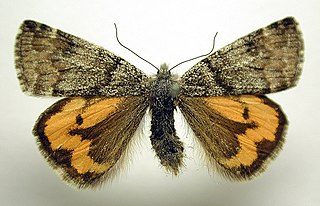
Archiearis notha, the light orange underwing, is a moth of the family Geometridae. The species was first described by Jacob Hübner in 1803 and can be found in Europe.
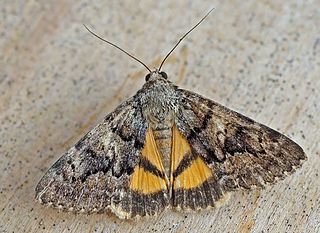
Catocala nymphaea is a species of moth of the family Erebidae. It was described by Eugenius Johann Christoph Esper in 1787. It is found in southern France, Austria, Albania, Portugal, Croatia, Italy, Greece, Corsica, Sicily, Crete, North Africa, Anatolia, Afghanistan and Kashmir.

Polyphaenis sericata, the Guernsey underwing, is a moth of the family Noctuidae. The species was first described by Eugenius Johann Christoph Esper in 1787. It is found in Europe and Asia.

Setina aurita is a moth of the family Erebidae. It was first described by Eugenius Johann Christoph Esper in 1787.
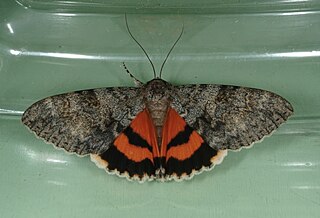
Catocala amatrix, the sweetheart underwing, is a moth of the family Erebidae. The species can be found from Nova Scotia, south through Connecticut to Florida and west through Texas and Oklahoma to Arizona and north to Montana, Minnesota, and Ontario.

Gluphisia crenata, the dusky marbled brown, is a moth of the family Notodontidae. The species was first described by Eugenius Johann Christoph Esper in 1785. It is found in Europe, east over parts of Russia and China up to Japan. It is also found in North America, where it was traditionally treated as a separate species, Gluphisia septentrionis.

Catocala conversa is a moth of the family Erebidae first described by Eugenius Johann Christoph Esper in 1787. It is found in the Mediterranean zone and parts of the sub-Mediterranean zone.

Gypsonoma aceriana, the poplar shoot-borer, is a moth of the family Tortricidae. It is found from Europe to Russia, eastern Turkey and Iraq. It is also present in North Africa.
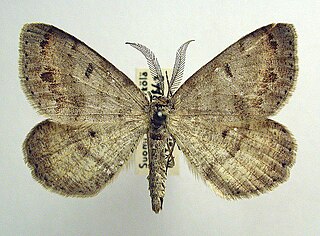
Macaria loricaria, the false Bruce spanworm or Eversmann's peacock, is a moth of the family Geometridae. It is found from Fennoscandia and the Baltic states to Sakhalin. It is also found in North America, where it is found from Alaska to Newfoundland and New York, south to Colorado.

Lithophane furcifera, the conformist, is a moth of the family Noctuidae. The species was first described by Johann Siegfried Hufnagel in 1766. It is found from central Europe, east to the Black Sea region, the Caucasus and western Siberia. In the mountains, it is found up to elevations of 1,800 meters.
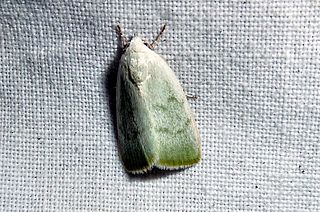
Earias vernana is a species of moth in the family Nolidae first described by Johan Christian Fabricius in 1787. It is found in most of southern and central Europe.

Gelechia turpella, the grand groundling, is a moth of the family Gelechiidae. It is widely distributed in Europe. Outside of Europe, it is found from the Caucasus to Siberia and the Russian Far East. The habitat consists of woodlands and parks.

Archips mortuanus, the dusky-back leaf roller, is a species of moth of the family Tortricidae. It is found in eastern North America, where it has been recorded from Maine, Michigan and New York.
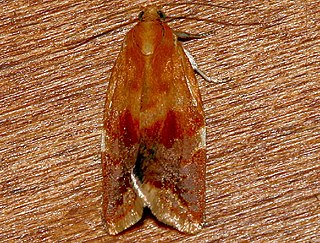
Clepsis persicana, the white triangle tortrix or the green needleworm, is a species of moth of the family Tortricidae. It is found in North America, where it has been recorded from Alaska and British Columbia to Newfoundland and south to Virginia and west to California. The habitat consists of coniferous and mixed coniferous forests.
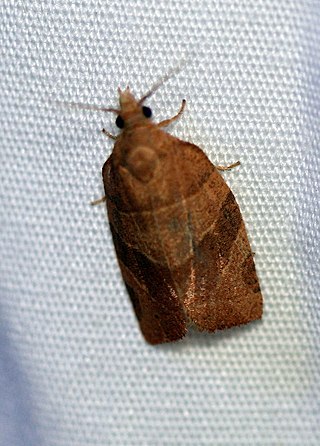
Pandemis limitata, the three-lined leafroller, is a species of moth of the family Tortricidae. It is found in North America, where it has been recorded from Nova Scotia to British Columbia and from the east coast west to the Rocky Mountains and Arizona. It has also been recorded from Durango in Mexico.

Acleris roscidana is a species of moth of the family Tortricidae. It is found in France, Germany, Austria, Switzerland, Italy, the Czech Republic, Slovakia, Hungary, Poland, Romania, Norway, Sweden, Finland, the Baltic region, Ukraine and Russia.
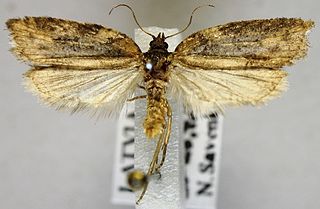
Acleris scabrana, the gray rough-wing moth, is a species of moth of the family Tortricidae. It is found in Europe, where it has been recorded from France, Belgium, the Netherlands, Germany, Austria, Switzerland, the Czech Republic, Slovakia, Poland, Hungary, Romania, Finland, Latvia, Lithuania, Ukraine and Russia. It is also found in Kazakhstan, Tian Shan, Yakutia, Asia Minor and North America, where it has been recorded from Alberta and British Columbia to California.
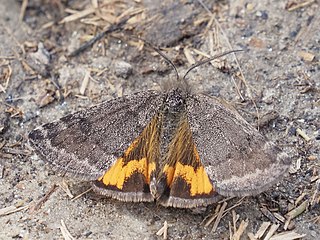
Boudinotiana is a genus of geometrid moths in the family Geometridae. There are at least four described species in Boudinotiana.




















